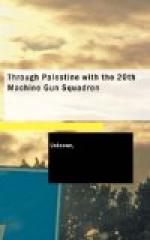“In February the 14th Cavalry Brigade held a Race Meeting on a short grass track of two and a half furlongs, discovered hiding among the rocks. A ‘totalisator’ run by an Australian in the interest of the Brigade, was run on sound lines, and if your horse won you got your money back and a little over, which isn’t the case with some totalisators that we know of! Several ‘scurries’ and mule races took place, and everyone enjoyed the fun thoroughly, especially the mules. The machine-gun element sprung a surprise on all by winning the Grand Prix, open to the 5th Cavalry Division, with ‘Nobbler,’ a horse which was to have run at Gaza in 1918, but was ‘scratched’ owing to lameness. ‘Lion,’ a mobilisation horse of the Sherwood Rangers, and a prime favourite, came in second, and both horses were ridden at 11-7.
[Illustration: Aleppo.
Squadron camp in the town.]
“THE FIRST ALEPPO MEETING.
“In March the 14th Cavalry Brigade took over its Aleppo quarters from the 13th, and the latter were moved many miles to the north, where they also held a local meeting. Capt. Fraser of the R.H.A. was now given the task of turning a waste piece of ground on the western side of the town into a racecourse, and, by dint of much hard work and begging of materials, he completed a quite good course of four furlongs. The Royal Engineers erected a grand stand of sandbags, and a totalisator. The first Aleppo Race Meeting was held on March 8th, and a goodly representative gathering of the army and civilian inhabitants of Aleppo assembled. After this, race meetings were held regularly every alternate Saturday throughout the summer. The course was laid on fairly level ground, and at the start of the season had a thin covering of grass, which, unfortunately, soon was burnt up by the fierce sun and worn bare by frequent use, being replaced afterwards by litter. Though at first only a four furlong ‘scurry,’ the course has now been extended to eight furlongs, and laid much in the same fashion as Kempton Park with a ‘straight’ of four furlongs and the remainder an oval. One drawback to this course is that it crosses a high road in two places. On race days mounted military police are stationed outside the rails to keep order, and British troops are on duty in the enclosures keeping the gates, serving refreshments, and assisting in the totalisator. The latest attraction has been the admirable rendering of popular music by the Band of the Queen’s Bays.
“INCIDENTS AT THE RACES.
“Of amateur jockeys and gentlemen riders there have been plenty; among the most successful being Lieut.-Col. Vincent, R.A.S.C., Major Walker, R.A., Capt. Sir Robin Paul, Lieut. Dowling. We much missed Lieut. Stanley Wooten, of the Sherwood Rangers Yeomanry, who has hitherto been such a popular rider in the E.E.F. Major-Gen. Sir Harry MacAndrew, C.B., D.S.O., Lieut.-Gen. Sir H.G. Chauvel, K.C.B.,




